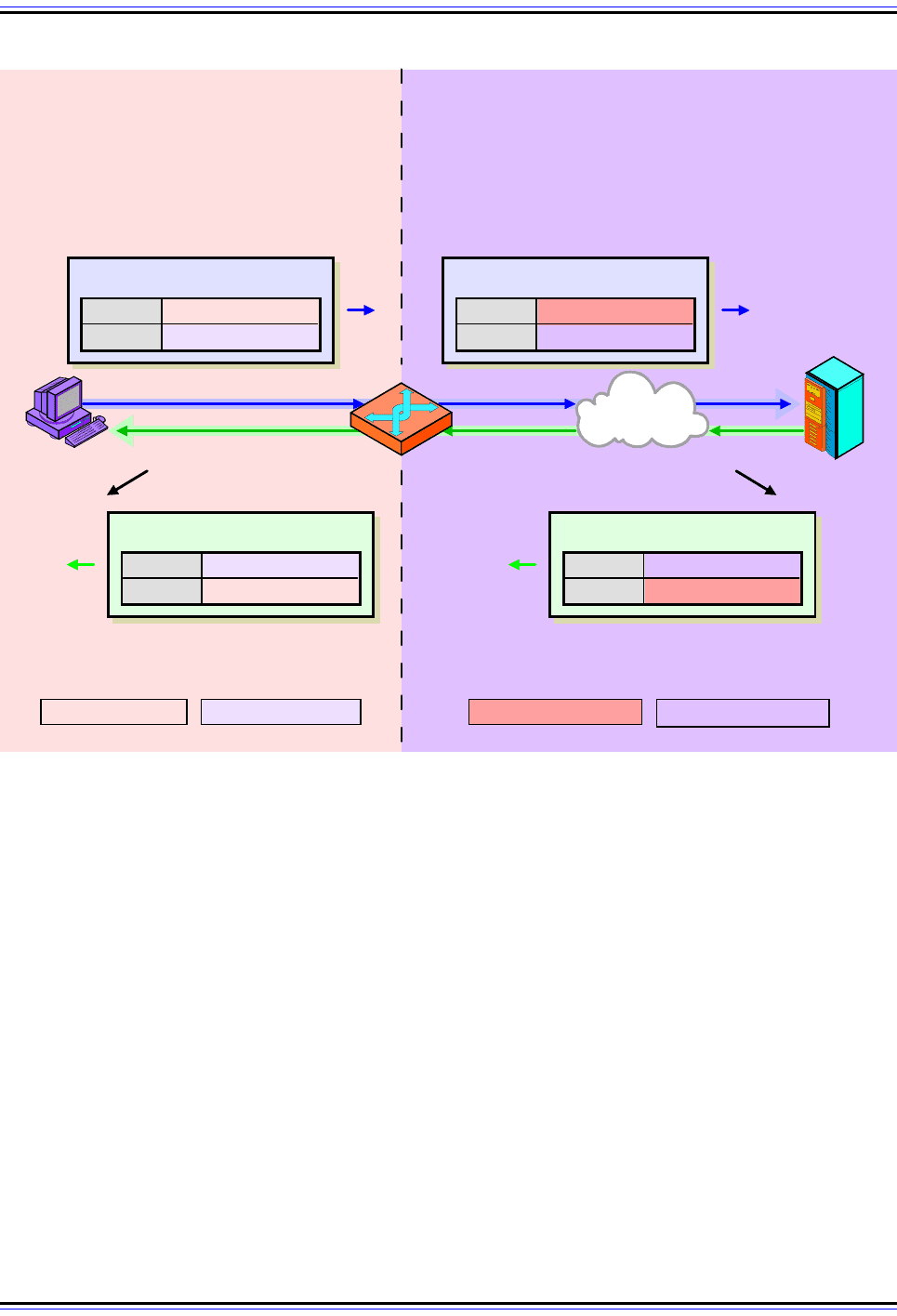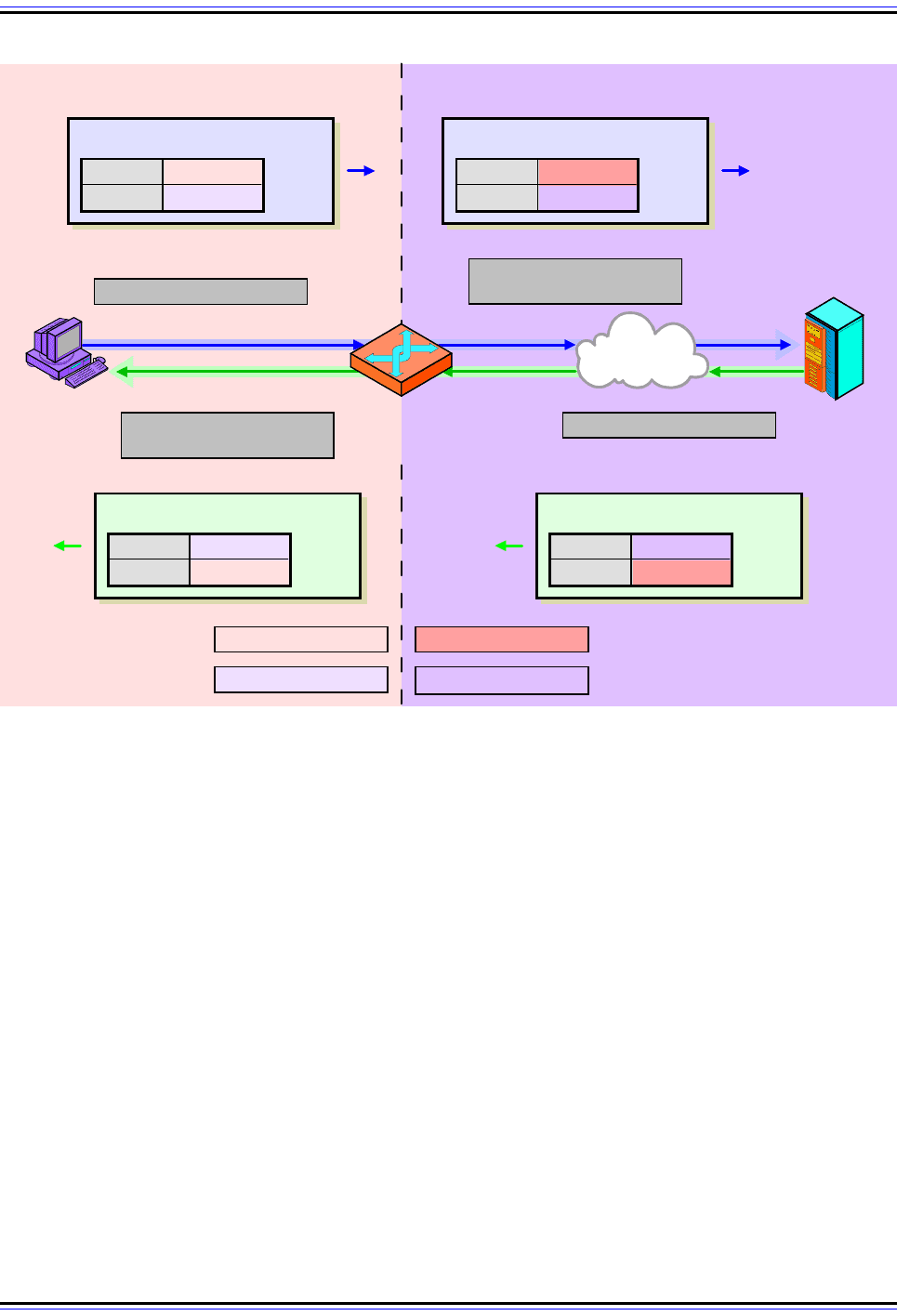Charles M. Kozierok The TCP-IP Guide
Подождите немного. Документ загружается.


The TCP/IP Guide - Version 3.0 (Contents) ` 521 _ © 2001-2005 Charles M. Kozierok. All Rights Reserved.
Key Concept: IP Network Address Translation (IP NAT or NAT) is a technique that
allows an organization to set up a network using private addresses, while still being
able to communicate on the public Internet. A NAT-capable router translates private
to public addresses and vice-versa as needed. This allows a small number of public IP
addresses to be shared amongst a large number of devices, and provides other benefits as
well (but also has some drawback).
Advantages of NAT
NAT is one of those technologies that has a long list of both advantages and disadvan-
tages. This means it can be extremely useful in a variety of scenarios, but also problematic
in others. The main advantages are:
☯ Public IP Address Sharing: A large number of hosts can share a small number of
public IP addresses. This saves money and also conserves IP address space.
☯ Easier Expansion: Since local network devices are privately addressed and a public
IP address isn't needed for each one, it is easy to add new clients to the local network.
☯ Greater Local Control: Administrators get all the benefits of control that come with a
private network, but can still connect to the Internet.
☯ Greater Flexibility In ISP Service: Changing the organization's Internet Service
Provider (ISP) is easier because only the public addresses change. It isn't necessary
to renumber all the client machines on the network.
☯ Increased Security: The NAT translation represents a level of indirection. Thus, it
automatically creates a type of firewall between the organization's network and the
public Internet. It is more difficult for any client devices to be accessed directly by
someone malicious because the clients don't have publicly-known IP addresses.
☯ (Mostly) Transparent: NAT implementation is mostly transparent, because the
changes take place in one or perhaps a few routers. The dozens or hundreds of hosts
themselves don't need to be changed.
Disadvantages of NAT
The above are all good reasons to use NAT, but there are drawbacks to the technique as
well. Some of these take away part of the benefit in certain items in the list above:
☯ Complexity: NAT represents one more complexity in setting up and managing the
network. It also makes troubleshooting more confusing due to address substitutions.
☯ Problems Due to Lack of Public Addresses: Certain functions won't work properly
due to lack of a “real” IP address in the client host machines.
☯ Compatibility Problems With Certain Applications: I said above that NAT was only
mostly transparent. There are in fact compatibility issues with certain applications that
arise because NAT “tinkers” with the IP header fields in datagrams but not in the appli-
cation data. This means tools like FTP, which pass IP addresses and port numbers in
commands, must be specially handled, and some applications may not work.

The TCP/IP Guide - Version 3.0 (Contents) ` 522 _ © 2001-2005 Charles M. Kozierok. All Rights Reserved.
☯ Problems With Security Protocols: Protocols like IPSec are designed to detect
modifications to headers and commonly balk at the changes that NAT makes, since
they cannot differentiate those changes from malicious datagram “hacking”. It is still
possible to combine NAT and IPSec, but this becomes more complicated.
☯ Poor Support for Client Access: The lack of a public IP address for each client is a
double-edged sword; it protects against hackers trying to access a host but also
makes it difficult for legitimate access to clients on the local network. “Peer-to-peer”
applications are harder to set up, and something like an organizational web site
(accessed from the Internet as a whole) usually needs to be set up without NAT.
☯ Performance Reduction: Each time a datagram transitions between the private
network and the Internet, an address translation is required. In addition, other work
must be done as well, such as recalculating header checksums. Each individual trans-
lation takes little effort but when you add it up, you are giving up some performance.
Many organizations feel that the advantages outweigh the disadvantages, especially if they
do use the Internet in primarily a client/server fashion, as most do. For this reason NAT has
become quite popular. One should always bear in mind, however, that the main problem
that led to NAT is lack of address space. IPv6 fixes this problem, while NAT merely finds a
clever “workaround” for it. For this reason, many people consider NAT a “kludge”. Once
IPv6 is deployed, it will no longer be needed, and some folks don't like it even for IPv4. On
the other hand, some feel its other benefits make it worthy of consideration even in IPv6.
Note: A “kludge” (or “kluge”) is something that is used to address a problem in an
inelegant way, like hammering a nail using the side of an adjustable wrench. (I
would never do such a thing, of course not…)
IP NAT Address Terminology
As its name clearly indicates, IP Network Address Translation is all about the translation of
IP addresses. When datagrams pass between the private network of an organization and
the public Internet, one or more of the addresses in these datagrams are changed by the
NAT router. This translation means that every transaction in a NAT environment involves
not just a source address and a destination address, but potentially multiple addresses for
each of the source and destination.
In order to make more clear the explanation of how NAT operates, several special designa-
tions have been developed to refer to the different types of addresses that can be found in
an IP datagram when NAT is used. Unfortunately, the terminology used for addressing in
NAT can be confusing, because it's hard to visualize what the differences are between the
(often similar-sounding) names. However, without knowing what these addresses mean a
proper understanding of NAT operation is impossible, so we need to start by explaining
them.

The TCP/IP Guide - Version 3.0 (Contents) ` 523 _ © 2001-2005 Charles M. Kozierok. All Rights Reserved.
NAT Address Terms Based on Device Location (Inside/Outside)
The first way that addresses are differentiated is based on where in the network the device
is that the address refers to:
☯ Inside Address: Any device on the organization's private network that is using NAT is
said to be on the inside network. Thus, any address that refers to a device on the local
network in any form is called an inside address.
☯ Outside Address: The public internet—that is, everything outside the local network—
is considered the outside network. Any address that refers to a public Internet device
is an outside address.
Key Concept: In NAT, the terms inside and outside are used to identify the location
of devices. Inside addresses refer to devices on the organization’s private network;
outside addresses refer to devices on the public Internet.
NAT Address Terms Based on Datagram Location (Local/Global)
An inside device always has an inside address; an outside device always has an outside
address. However, there are two different ways of addressing either an inside or an outside
device, depending on in which part of the network the address appears in a datagram:
☯ Local Address: This term describes an address that appears in a datagram on the
inside network, whether it refers to an inside or outside address.
☯ Global Address: This term describes an address that appears in a datagram on the
outside network, again whether it refers to an inside or outside address.
Key Concept: In NAT, the terms local and global are used to indicate in what
network a particular address appears. Local addresses are used on the organi-
zation’s private network (whether to refer to an inside device or an outside device);
global addresses are used on the public Internet (again, whether referring to an inside or
outside device).
Combining Inside/Outside and Local/Global Address Designations
This is a bit confusing, so I will try to explain further. The NAT translating router has the job
of interfacing the inside network to the outside network (the Internet). Inside devices need
to be able to talk to outside devices and vice-versa, but inside devices can only use
addressing consistent with the local network addressing scheme. Similarly, outside devices
cannot use local addressing. Thus, both inside and outside devices can be referred to with
local or global address versions. This yields four different specific address types:

The TCP/IP Guide - Version 3.0 (Contents) ` 524 _ © 2001-2005 Charles M. Kozierok. All Rights Reserved.
1. Inside Local Address: An address of a device on the local network, expressed using
its normal local device representation. So for example, if we had a client on a network
using the 10.0.0.0 private address block, and assigned it address 10.0.0.207, this
would be its inside local address.
2. Inside Global Address: This is a global, publicly-routable IP address used to
represent an inside device to the outside world. In a NAT configuration, inside global
addresses are those “real” IP addresses assigned to an organization for use by the
NAT router.
Let's say that device 10.0.0.207 wants to send an HTTP request to an Internet server
located at address 204.51.16.12. It forms the datagram using 10.0.0.207 as the source
address. However, if this datagram is sent out to the Internet as is, the server cannot reply
back because 10.0.0.207 is not a publicly-routable IP address. So the NAT router will
translate 10.0.0.207 in the datagram into one of the organization's registered IP addresses,
say it's 194.54.21.10. This is the inside global address that corresponds to 10.0.0.207. It will
be used as the destination when the server sends its HTTP response. Note that in some
situations the inside local address and outside local address may be the same.
3. Outside Global Address: An address of an external (public Internet) device as it is
referred to on the global Internet. This is basically a regular, publicly-registered
address of a device on the Internet. In the example above, 204.51.16.12 is an outside
global address of a public server.
4. Outside Local Address: An address of an external device as it is referred to by
devices on the local network. In some situations, this may be identical to the outside
global address of that outside device.
Local/Global Address Designations from the Perspective of Device Location
Phew, it's still confusing, isn't it? Let's try another way of looking at this. Of these four
addresses, two types are the addresses as they are known “natively” by either an inside or
outside device, while two are translated addresses:
☯ Inside Device Designations: For an inside device, the inside local address is its
“normal” or “native” address. The inside global address is a translated address used to
represent the inside device on the outside network, when necessary.
☯ Outside Device Designations: For an outside device, the outside global address is
its “normal/native” address. The outside local address is a translated address used to
represent the outside device on the inside network, when necessary.
So, what NAT does then is translate the identity of either inside or outside devices from
local representations to global representations and vice-versa. Which addresses are
changed, and how, depends on the specific type of NAT employed. For example, in tradi-
tional NAT, inside devices refer to outside devices using their proper (global) representation,
so the outside global and outside local addresses of these outside devices are the same.

The TCP/IP Guide - Version 3.0 (Contents) ` 525 _ © 2001-2005 Charles M. Kozierok. All Rights Reserved.
Key Concept: A NAT router translates local addresses to global ones, and vice-
versa. Thus, an inside local address is translated to an inside global address (and
vice-versa) and an outside local address is translated to an outside global address
(and vice-versa).
Graphical Illustration of NAT Terminology
And after all that… it's still confusing. ☺ One of the big problems is that the words “inside”
and “local” are somewhat synonymous, as are “outside” and “global”, yet they mean
different things in NAT. And the typical paradox in trying to explain networking concepts
rears its ugly head here again: I wanted to define these addresses to make describing NAT
operation easier, but find myself wanting to use an example of NAT operation to clarify how
the addresses are used.
Even after writing this section I find these terms confusing, so I created Figure 111, which
shows this same terminology in graphical form and may be of some help. That diagram is
also used as a template for the illustrations of each of the different types of NAT in subse-
quent topics, which use the same color coding for each of the four address types for
consistency. As you read the topics that discuss NAT operation, remember to look back
here if you want to double-check the meaning of address types. Don't get discouraged if it
takes a couple of times to get the addresses straight.
IP NAT Static and Dynamic Address Mappings
NAT allows us to connect a private (inside) network to a public (outside) network such as
the Internet, by using an address translation algorithm implemented in a router that
connects the two. Each time a NAT router encounters an IP datagram that crosses the
boundary between the two networks it must translate addresses as appropriate. But how
does it know what to translate, and what to use for the translated address?
The NAT software in the router must maintain a translation table to tell it how to operate.
The translation table contains information that maps the inside local addresses of internal
devices (their regular addresses) to inside global address representations (the special
public addresses used for external communication). It may also contain mappings between
outside global addresses and outside local addresses for inbound transactions, if
appropriate.
There are two basic ways that entries can be added to the NAT translation table.
Static Mappings
When static mappings are used, a permanent, fixed relationship is defined between a
global and a local representation of the address of either an inside or an outside device. For
example, we can use a static translation if we want the internal device with an inside local

The TCP/IP Guide - Version 3.0 (Contents) ` 526 _ © 2001-2005 Charles M. Kozierok. All Rights Reserved.
address of 10.0.0.207 to always use the inside global address of 194.54.21.10. Whenever
10.0.0.027 initiates a transaction with the Internet, the NAT router will replace that address
with 194.54.21.10.
Dynamic Mappings
With dynamic mappings, global and local address representations are generated automati-
cally by the NAT router, used as needed, and then discarded. The most common way that
this is employed is in allowing a pool of inside global addresses to be shared by a large
number of inside devices.
For example, say we were using dynamic mapping with a pool of inside global addresses
available from 194.54.21.1 through 194.54.21.20. When 10.0.0.207 sent a request to the
Internet it would not automatically have its source address replaced by 194.54.21.10. One
of the 20 addresses in the pool would be chosen by the NAT router. The router would then
Figure 111: IP Network Address Translation (NAT) Terminology
Hopefully this diagram will help you better understand the whole “inside/outside/local/global” thing. ☺
Client
10.0.0.207
Server
204.51.16.12
NAT
Router
Internet
Local Network
("Inside")
Public Internet
("Outside")
Inside Local Address Outside Local Address Inside Global Address
Outside Global Address
All Devices Inside The Local Network
Are Referenced Using An Inside Address
(Inside Local or Inside Global)
All Devices Outside The Local Network
Are Referenced Using An Outside Address
(Outside Local or Outside Global)
All Addresses Used In Datagrams
Inside The Local Network Are Local
All Addresses Used In Datagrams
Outside The Local Network Are Global
Source Inside Local
Destination Outside Local
Outbound Datagram
Source Inside Global
Destination Outside Global
Translated Datagram
Source Inside Global
Destination Inside Local
Translated Datagram
Source Outside Global
Destination Inside Global
Inbound Datagram
"Native" Address
(Inside Local)
"Native" Address
(Outside Global)

The TCP/IP Guide - Version 3.0 (Contents) ` 527 _ © 2001-2005 Charles M. Kozierok. All Rights Reserved.
watch for replies back using that address and translate them back to 10.0.0.207. When the
session was completed, it would discard the entry to return the inside global address to the
pool.
Comparing Static and Dynamic Mappings
The trade-offs between static and dynamic NAT mappings are pretty much the same as
they always are when the choice is between “static” and “dynamic”; for example, the same
issues arises in ARP caching. Static mappings are permanent and therefore ideal for
devices that need to be always represented with the same public address on the outside
network. They may also be used to allow inbound traffic to a particular device; that is, for
transactions initiated on the public network that send to a special server on the inside
network. However, they require manual setup and maintenance, and they don't allow IP
sharing on the internal network.
Dynamic mapping is normally used for regular clients in order to facilitate public IP address
sharing, a prime goal of most NAT implementations. It is more complicated than static
mapping, but once set up is automatic.
It is possible to mix dynamic and static mapping on the same system, of course. We can
designate certain devices that are statically mapped and let the rest use dynamic mapping.
We just have to make sure that the static mappings don't overlap with the pool used for
dynamic assignment.
Incidentally, another way that dynamic mapping of global and local addressing is performed
is through domain name resolution using DNS. This is particularly common when external
devices access internal hosts using bidirectional NAT (inbound transactions). Since hosts
on the public Internet know nothing about the organization's private network, they issue a
request for the DNS name of the device they want to access. This causes a NAT translation
entry to be generated that maps the inside local public address of the host to an inside
global address for use by those outside the network. See the description of bidirectional
NAT for more details on how this works.
IP NAT Unidirectional (Traditional/Outbound) Operation
Now that we understand the motivation behind NAT and its pros and cons, and have also
covered NAT address terminology and translation table creation, it's time to get down to the
nitty gritty of how it works. There are many different flavors of NAT, and four common ones
are covered in this Guide. It makes sense to start by looking at the original variety of NAT
described in RFC 1631. This is the simplest NAT method and therefore the easiest one to
explain.
NAT was of course designed to allow hosts on a private network to share public IP
addresses in accessing an Internet. Since most hosts are clients that initiate transactions,
NAT was designed under the assumption that a client/server request/response communi-
cation would begin with a datagram sent from the inside network to the outside. For this

The TCP/IP Guide - Version 3.0 (Contents) ` 528 _ © 2001-2005 Charles M. Kozierok. All Rights Reserved.
reason, this first type of NAT is sometimes called Unidirectional or Outbound NAT. Since it
is the oldest flavor it is also now called Traditional NAT, to differentiate it from newer
varieties.
Unidrectional NAT Example
To show how unidirectional NAT works, we will of course use an example. Explaining things
is always easier with examples, especially when it is a confusing thing like NAT. Let's use
the same numbers from the previous two topics. We'll assume the inside network has 250
hosts that use private (inside local) addresses from the 10.0.0.0/8 address range (which I
selected because it has small numbers!) These hosts use dynamic NAT sharing a pool of
20 inside global addresses from 194.54.21.1 through 194.54.21.20.
In our example, device 10.0.0.207 wants to access the World Wide Web server at public
address 204.51.16.12. Table 75 shows the four basic steps that are involved in this
(simplified) transaction. I did this in table form instead of bullet points so I could show you
explicitly what happens to the addresses in both the request datagram (in steps #1 and #2)
and the response datagram (steps #3 and #4). I have also highlighted the translated
address values for clarity, and provided Figure 112, which shows the process graphically.

The TCP/IP Guide - Version 3.0 (Contents) ` 529 _ © 2001-2005 Charles M. Kozierok. All Rights Reserved.
As you can see, this really isn’t rocket science, and it’s fairly easy to understand what is
going on as soon as you get used to the terminology and concepts. In unidirectional NAT
the source address is translated on outgoing datagrams and the destination address on
Table 75: Operation Of Unidirectional (Traditional/Outbound) NAT
Step
#
Description
Data-
gram
Type
Datagram
Source
Address
Datagram
Destination
Address
1
Inside Client Generates Request And Sends
To NAT Router: Device 10.0.0.207 generates an
HTTP request that is eventually passed down to
IP and encapsulated in an IP datagram. The
source address is itself, 10.0.0.207, and the
destination is 204.51.16.12. The datagram is sent
to the NAT-capable router that connects the
organization's internal network to the Internet.
Request
(from
inside
client to
outside
server)
10.0.0.207
(Inside Local)
204.51.16.12
(Outside Local)
2
NAT Router Translates Source Address and
Sends To Outside Server: The NAT router
realizes that 10.0.0.207 is an inside local address
and knows it must substitute an inside global
address in order to let the public Internet desti-
nation respond. It consults its pool of addresses
and sees the next available one is 194.54.21.11.
It changes the source address in the datagram
from 10.0.0.207 to 194.54.21.11. The destination
address is not translated in traditional NAT. In
other words, the outside local address and
outside global address are the same.
The NAT router puts the mapping from
10.0.0.207 to 194.54.21.11 into its translation
table. It sends out the modified datagram, which
is eventually routed to the server at 204.51.16.12.
194.54.21.11
(Inside Global)
204.51.16.12
(Outside Global)
3
Outside Server Generates Response And
Sends Back To NAT Router: The server at
204.51.16.12 generates an HTTP response. It of
course has no idea that NAT was involved; it sees
194.54.21.11 in the request sent to it, so that's
where it sends back the response. It is then
routed back to the original client's NAT router.
Response
(from
outside
server to
inside
client)
204.51.16.12
(Outside Global)
194.54.21.11
(Inside Global)
4
NAT Router Translates Destination Address
And Delivers Datagram To Inside Client: The
NAT router sees 194.54.21.11 in the response
that arrived from the Internet. It consults its trans-
lation table and knows this datagram is intended
for 10.0.0.207. This time the destination address
is changed but not the source. It then delivers the
datagram back to the originating client.
204.51.16.12
(Outside Local)
10.0.0.207
(Inside Local)

The TCP/IP Guide - Version 3.0 (Contents) ` 530 _ © 2001-2005 Charles M. Kozierok. All Rights Reserved.
incoming ones. Traditional NAT only supports this sort of outbound transaction, which is
started by a device on the inside network. It cannot handle a device on the public Internet
sending a request to a private address.
Other Functions of the Router in NAT
Also note that even though I am focusing on the changes that the NAT router makes to
addresses, it also has to make other changes to the datagram. Changing any field in the IP
header means that the IP Header Checksum field will need to be recalculated. UDP and
TCP checksums need to be recalculated, and depending on the nature of the data in the
datagram, other changes may also be required. I discuss these issues in the topic on NAT
compatibility issues.
This simplified example assumes the existence of just one router between the private and
public networks. It is possible to have more than one router between these networks. If this
configuration is used, however, it is essential that they both use the same translation table.
Otherwise, if the request is processed by router R1 but the response received by router R2,
Figure 112: Operation Of Unidirectional (Traditional/Outbound) NAT
The four steps in this process can be seen by following the steps in clockwise order. Translated addresses are
shown in bold. Please refer to Table 75 for an explanation of the steps in this diagram, or to Figure 111 for an
explanation of the four address types.
Source 10.0.0.207
Destination 204.51.16.12
Request
Source
194.54.21.11
Destination 204.51.16.12
Translated Request
Source 204.51.16.12
Destination
10.0.0.207
Translated Response
Source 204.51.16.12
Destination 194.54.21.11
Response
1. Client Sends Request
Client
10.0.0.207
Server
204.51.16.12
2. NAT Router Translates
Source Address
NAT
Router
3. Server Sends Response
4. NAT Router Translates
Destination Address
Internet
Local Network
("Inside")
Public Internet
("Outside")
Inside Local Address
Outside Local Address
Inside Global Address
Outside Global Address
